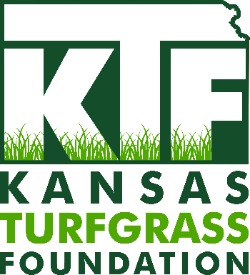Selection
- Turfgrass Categories Based on Function, Maintenance, and Quality
- Cool Season and Warm Season Species
- Cultivars and Varieties, and Blends and Mixes
- Turfgrass Species for the Midwest
- Other Species Occasionally Used in the Midwest
- Turfgrass Selection Summary
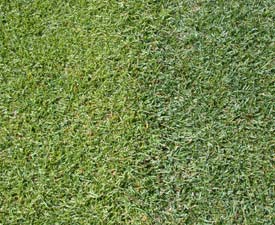 Careful turfgrass selection is an important first step in establishing, overseeding, or renovating a turfgrass. Many potential problems related to turf use, appearance, environment, insect or disease pests, and cultural practices can be avoided by properly choosing species and cultivars that best fit the situation in which the turfgrass will be grown.
Careful turfgrass selection is an important first step in establishing, overseeding, or renovating a turfgrass. Many potential problems related to turf use, appearance, environment, insect or disease pests, and cultural practices can be avoided by properly choosing species and cultivars that best fit the situation in which the turfgrass will be grown.
A turfgrass, when planted in areas where it is not adapted, often deteriorates or fails. The result of planting a turfgrass where it is not adapted is a poor-quality turf that requires excessive pesticide applications, fertilization, and replanting to retain a green ground cover. A high-quality turf may not be obtainable in this situation.
Consider these criteria when selecting a turfgrass:
- Desired quality
- Appearance – turf color, texture, density, growth habit, and uniformity
- Use – turf purpose, e. g., athletic or play surface, lawn, erosion control
- Pest resistance – turf resistance or tolerance to disease or insect pests
- Culture – turf management requirements from a time and a financial view point
- Site – turf soil and sunlight requirements compared to those of the final planting site.
Turfgrasses differ with regard to these criteria. For example, some Kentucky bluegrass cultivars form a dark emerald green turf adapted to high maintenance and light shade. This can be contrasted with buffalograss, a gray-green, low-maintenance turfgrass that performs poorly in light shade. Other differences among species and cultivars also exist regarding wear tolerance, environmental adaptation, pest resistance, and cultural requirements. Careful selection at planting time is the best way to solve potential problems in the future.
Generally, the cost of planting turfgrasses, whether from seed, sod, plugs, sprigs, or stolons, should be of minimal concern. In most normal plantings, the cost difference between poor-quality and high-quality seed or vegetative propagules is small, and the time and money spent trying to produce high-quality turf from low-quality seed or vegetative material can often become great. The long-term benefit of planting high-quality turfgrasses in appropriate conditions is a healthy, cost-effective, quality turf.
Turfgrass Categories Based on Function, Maintenance, and Quality
Frequently, turfgrasses are divided into three groups based on function, maintenance requirements, and quality. Turfgrasses that serve mainly as erosion controls, receive minimal maintenance, and have minimal quality are termed utility turfgrasses. Pasture-type tall fescues, fine fescues, common Kentucky bluegrasses, and buffalograsses fall into this category. Grasses from this group are commonly used on roadsides, industrial areas, low-use park areas, and other low-maintenance settings.
Turfgrasses grown for their aesthetic appeal, moderate maintenance, and moderate to high quality are placed in the lawn turfgrass category. Common and improved types of Kentucky bluegrass, perennial ryegrasses, turf-type tall fescues, fine fescues, bermudagrasses, zoysiagrasses, and buffalograsses are included in this group. These turfgrasses are commonly planted on home lawns, commercial areas, park settings, and other landscape areas requiring turf having a good appearance.
Sports turfgrasses function as athletic or recreation play surfaces, generally receive high maintenance, and are of high quality. Improved Kentucky bluegrasses, perennial ryegrasses, creeping bentgrasses, turf-type tall fescues, bermudagrasses, and zoysiagrasses are used as sports turfgrasses in various parts of the Midwest. These grasses are often grown on golf course greens, tees, fairways, and roughs; baseball; football; and other sports sites.
Cool Season and Warm Season Species
Most turfgrasses used in the Midwest are cool season grasses; Kentucky bluegrasses, perennial ryegrasses, tall fescues, fine-leaf fescues, and creeping bentgrasses fall in this group. Cool season grasses grow actively during the spring and autumn when air and soil temperatures are cool. Optimum growth of these grasses occurs when soil temperatures are between 50° and 65°F and air temperatures are between 60° and 75°F. Creeping bentgrass, Kentucky bluegrass, and the fine fescues possess acceptable cold tolerance, while tall fescue and perennial ryegrass are generally considered to be somewhat less tolerant of cold. Established tall fescue, on the other hand, has good heat and drought tolerance and is often grown in the southern portions of the Midwest. Kentucky bluegrasses, perennial ryegrasses, fine-leaf fescues, and creeping bentgrasses have less tolerance to heat and drought. All of these cool season turfgrasses are easily established by seeding, while Kentucky bluegrasses, creeping bentgrasses, and occasionally tall fescues are also established by sodding.
Three other turfgrass species, bermudagrass, zoysiagrass and buffalograss, are occasionally grown in areas of the Midwest. These are warm season grasses, that is, grasses more tolerant of high temperatures and drought conditions than their cool season counterparts. Optimum growth of these grasses occurs when soil temperatures are between 70° and 90°F and air temperatures are between 80° and 95°F. Bermudagrass is the least cold tolerant of the three and may best be used in the southern areas of the Midwest. Buffalograss is the most cold tolerant of this group and can perform admirably in most areas of the region. Zoysiagrass is intermediate in cold tolerance; it should be grown in the central and southern portions of the Midwest. All three of these species, unfortunately, do not maintain green color and active growth in cool temperatures from mid-autumn through mid-spring. When dormant during these periods, they are brown and unattractive. Bermudagrass and zoysiagrass are most commonly established vegetatively (sod, sprigs, plugs, or stolons); buffalograss can be established by seed or vegetatively.
Cultivars and Varieties, and Blends and Mixes
Cultivars and varieties can be considered subtypes of a given turfgrass species. Cultivars and varieties possess most of the characteristics common to a turfgrass species, but are selected because they have a desirable trait(s) that sets them apart from the majority of the species population. For example, 'Merion' Kentucky bluegrass was selected and sold as a cultivar because it possessed a resistance to leaf spot that common Kentucky bluegrasses did not have. Another example, 'Shortstop' tall fescue, is different from most other tall fescues because it has a lower growing point and finer leaf texture.
Overall, turfgrass cultivars have been selected for traits such as improved appearance (color, density, growth habit, and leaf width), improved management (tolerance to close mowing and less frequent mowing, improved mowing quality and establishment speed), improved disease and insect resistance, and improved environmental tolerance (shade, heat, drought, wear, cold). Generally, it is recommended that improved cultivars, rather than common-type turfgrasses, be used where possible.
In the majority of settings in which cool season turfgrasses are grown, it is recommended that mixes (combinations of two or more species of turfgrass) and/or blends (combinations of two or more cultivars of the same species) be planted. By combining compatible grasses, growers can create greater tolerance to varied growing conditions in their turf sites. In addition, different grasses can bring varied pest tolerances and resistances to a site, thus reducing the potential for extensive turf damage caused by a single disease.
Turfgrass Species for the Midwest
The most commonly used turfgrasses in the Midwest are Kentucky bluegrass, perennial ryegrass, tall fescue, fine-leaf fescue, creeping bentgrass, and zoysiagrass. These species vary in growth habit, appearance, and maintenance requirements. The next sections will describe these turfgrasses (also buffalograss) and will detail their characteristics. Growth habits include rhizomatous (spread by underground stems), stoloniferous (spread by aboveground stems), and bunch (gradual increase in clump size). Appearance characteristics include overall turfgrass quality based on a combination of turfgrass color, leaf width, and density. Maintenance requirements include mowing, irrigating, fertilizing, cultivating, and controlling pests.
In addition, these grasses differ in environmental adaptation, wear tolerance, recuperative ability, and use. Environmental adaptation refers to the environment in which each turfgrass will normally perform best. For example, each turfgrass performs best in a particular type of soil and in a certain amount of light. Wear tolerance refers to a turfgrass's ability to withstand traffic, while recuperative ability indicates the turfgrass's ability to recover after damage that can result from insects, diseases, traffic, or environmental stresses. Finally, for each of these turfgrasses, information concerning normal uses is presented.
| Kentucky Bluegrass (Poa pratensis) | |
|---|---|
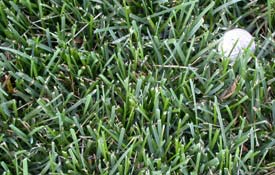 | |
Establishment Method | Seeding or sodding |
Appearance | Moderate to high quality depending on cultivar, management, and environment; medium texture; green to dark green with good density |
Growth Habit | Rhizomatous |
Wear Tolerance | Medium |
Environmental Adaptation | Well-drained, moist, neutral to slightly acid, fertile soils; full sun to light shade; good low-temperature tolerance; poor to fair drought tolerance, depending on management and cultivar |
Maintenance Requirements | Low to high depending on cultivar, use, and management level; mow frequently (depending on use), normal lawn heights are 2 to 3 inches; supply 2 to 4 pounds of nitrogen per 1,000 square feet per growing season; supply 1 to 1 1/2 inches of water per week during the growing season to maintain green and active growth; vigorous cultivars grown under high maintenance are prone to producing thatch; diseases and insects can be a problem depending on cultivar, use, management, and growth environment |
Recuperative Ability | Good |
Uses | Use low maintenance types in areas receiving minimal culture; improved types are generally used for home lawns, commercial sites, and other areas requiring attractive turf; Kentucky bluegrass is also used on golf course fairways, tees, and rough areas, and in other athletic settings because of its recuperative potential and appearance |
Other Notes | Most popular cool season turfgrass with many cultivars available; match cultivar to use and management level; slow to establish by seed; seedlings usually weak |
| Perennial Ryegrass (Lolium perenne) | |
|---|---|
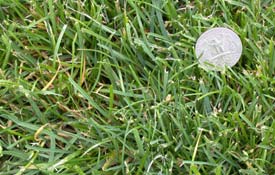 | |
Establishment Method | Seeding |
Appearance | Moderate to high quality depending on cultivar, management, and environment; medium texture with good density and uniformity; similar to Kentucky bluegrass |
Growth Habit | Bunch |
Wear Tolerance | Good |
Environmental Adaptation | Well-drained, moist, neutral to slightly acidic, fertile soils; full sun; avoid temperature extremes; lacks tolerance to excessive heat, cold, and drought |
Maintenance Requirements | Moderate to high depending on cultivar, use, and environment; mow frequently (depending on use), normal lawn heights are 2 to 3 inches; supply 2 to 4 pounds of nitrogen per 1,000 square feet per growing season; supply 1 to 1 1/2 inches of water per week during the growing season to maintain green and active growth; thatch is not a major problem due to bunch-type growth habit; some cultivars are susceptible to diseases, especially red thread and Pythium blight |
Recuperative Ability | Poor |
Uses | Use low maintenance types in areas receiving minimal culture; improved types are generally used with Kentucky bluegrass for home lawns, commercial sites, and other areas requiring attractive turf; perennial ryegrass is also used on golf course fairways, tees, and rough areas, and in other athletic settings because of its wear tolerance, appearance, and rapid germination |
Other Notes | Rarely used alone; usually combined with Kentucky bluegrass in full sun or with Kentucky bluegrass and fine fescue in shady areas; good tolerance to soil compaction; very good for overseeding and renovation; germinates rapidly and strongly; insect pests and diseases can be a problem |
| Tall fescue (Festuca arundinacea) | |
|---|---|
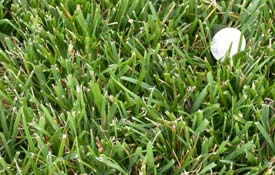 | |
Establishment Method | Seeding and occasionally sodding |
Appearance | Medium-coarse to coarse texture with low density |
Growth Habit | Bunch |
Wear Tolerance | Good, after establishment |
Environmental Adaptation | Adapts to wide range of soils and environments; full sun; tolerates some shade; does well in heat and drought; useful in the transition zone; tolerates short periods of submersion |
Maintenance Requirements | Low to moderate; mow frequently (depending on use), normal lawn heights are 2 to 3 1/2 inches; supply 2 to 4 pounds of nitrogen per 1,000 square feet per growing season; supply water as necessary; established tall fescues have good drought tolerance and will require modest irrigation during most Midwestern summers; thatch is not a major problem due to bunch-type growth habit; brown patch can be a disease problem during some years |
Recuperative Ability | Poor |
Uses | Lawns, parks, golf course roughs, and low maintenance areas in the central and southern portions of the Midwest; use turf- type tall fescues where moderate to moderately high-quality turf is desired and pasture types (such as 'Kentucky 31,' 'Alta 'Fawn') for utility purposes |
Other Notes | Can become an undesirable weed in other turfgrasses |
| Fine Fescues or Fine-leaf Fescues (Festuca species) | |
|---|---|
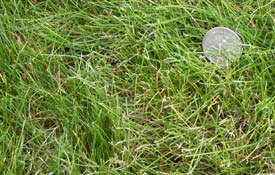 | |
Establishment Method | Seeding |
Appearance | Very fine to fine texture with good density and uniformity; red and chewings fescues are medium to dark green, sheep fescues tend to be distinctively blue-green, and hard fescues tend to be more gray-green; red fescues are rhizomatous, while other fine fescues have bunch-type growth habits |
Growth Habit | Rhizomatous or bunch |
Wear Tolerance | Poor to moderate |
Environmental Adaptation | The best cool season grasses for dry, shaded areas; often mixed with Kentucky bluegrasses and perennial ryegrasses in dry, shaded areas Red and chewings fescues (F. rubra)—well-drained, droughty, infertile, acid soil; light to moderate shade Sheep fescue (F. ovina)—well-drained, droughty, sandy, infertile, acid soil Hard fescue (F. longifolia)—less drought tolerant than sheep fescue, but more tolerant moist, fertile soils |
Maintenance Requirements | Low; mow frequently (depending on use), normal lawn heights are 2 to 3 inches; supply 1 to 3 pounds of nitrogen per 1,000 square feet per growing season; supply water as necessary; watch creeping types for thatch development; disease prone, especially when grown in moist, high-fertility settings |
Recuperative Ability | Medium to poor |
Uses | Lawns, parks, utility settings especially in light to moderate shade; avoid use in heavily trafficked areas or athletic settings |
Other Notes | None |
| Zoysiagrass (Zoysia species) | |
|---|---|
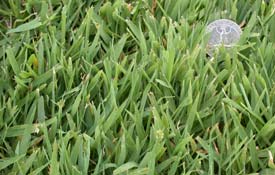 | |
Establishment Method | Vegetatively and occasionally seeding |
Appearance | Low growing and of medium texture with high density, quality, and uniformity; tan-brown during dormant season (midautumn to midspring) |
Growth Habit | Stoloniferous, rhizomatous |
Wear Tolerance | N/A |
Environmental Adaptation | Well-drained, moist, slightly acid, fertile soils; full sun to light shade; tolerates heat and drought well |
Maintenance Requirements | Moderate; good drought tolerance, irrigate as needed; mow at 1/2 to 1 1/2 inches; grass blades are tough and best appearance occurs when mowed with a reel-type mower; requires 1 to 3 pounds of nitrogen per 1,000 square feet per year and tolerates saline conditions relatively well; irrigate as needed, although grass is drought tolerant and will require minimal irrigation; produces much thatch, so periodic dethatching is usually required; limited insect and disease problems in the Midwest |
Recuperative Ability | Moderate to good |
Uses | Zoysiagrass is used in a variety of lawn and athletic turf settings, including home lawns, commercial lawns, golf course tees and fairways, football and soccer fields, and baseball fields |
Other Notes | Warm season grass; relatively short green period in much of the Midwest; expensive and slow (1 to 3 years) to establish |
| Buffalograss (Buchloe dactyloides) | |
|---|---|
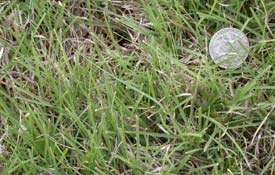 | |
Establishment Method | Seeding, vegetatively |
Appearance | Fine texture with low to moderate density and gray-green color during growing season; dull tan during dormant season (midautumn to midspring) |
Growth Habit | Stoloniferous |
Wear Tolerance | Medium |
Environmental Adaptation | Fine-textured, dry soils, but tolerates a wide range of soil types; full sun; will tolerate short periods of submersion; avoid shade |
Maintenance Requirements | Low; it requires 0 to 1 pound of nitrogen per 1,000 square feet per year; can be mowed infrequently at 2 to 3 inches; irrigation is rarely required after establishment; it appears to have few pest problems and has a low thatching tendency |
Recuperative Ability | Good |
Uses | Low-maintenance lawns, parks, industrial areas; its gray-green color and long dormancy period keep it from being used in settings requiring a highly attractive turf; slow establishment from seed reduces its usefulness in areas where soil erosion is a problem |
Other Notes | Warm season grass; relatively short green period; expensive and slow to establish |
Other Species Occasionally Used in the Midwest
Rough Bluegrass (Poa trivialis)
Rough bluegrass is a stoloniferous, fine-textured, cool season turfgrass that produces a poor quality turf. It does, however, have the ability to survive in wet, shaded areas better than other commonly grown turfgrasses. 'Sabre' rough bluegrass has been selected as an improvement on common rough bluegrass.
Bermudagrass (Cynodon dactylon)
Bermudagrass is a rhizomatous/stoloniferous, warm season turfgrass that is used occasionally in the southern portion of the Midwest. It has good heat and drought tolerance and exhibits good wear tolerance. In contrast to zoysiagrass, it can be established quickly, usually in 6 weeks. On the other hand, bermudagrass has poor cold and shade tolerance. It may periodically be damaged or killed during cold winters throughout the Midwest. 'Midiron' and 'Midway' bermudagrasses are vegetatively propagated types that have exhibited better cold tolerance than most other bermudagrasses. Several new seeded types are available, but have not been adequately tested in the Midwest to warrant recommendation.
Recommended turfgrass planting combinations for specific Midwest sites and applications.
| Utility, Lawn, and Other Non-sport Areas | |
|---|---|
Setting | Turfgrass |
Full Sun | Kentucky bluegrass blend (three or more Kentucky bluegrass cultivars) OR 80+ % Ky. bluegrass/perennial ryegrass OR Tall fescue blend (three or more tall fescue cultivars) OR bermudagrass (southern portion of Midwest) OR Buffalograss OR Zoysiagrass (southern portion of Midwest) |
Dry Shade | 30-50% blend of shade-tolerant Ky. bluegrasses + 50-70% fine-leaf fescues OR Tall fescue blend OR Zoysiagrass (southern portion of Midwest) |
Wet Shade | 70% or more rough bluegrass + remainder in blend of shade-tolerant Ky. bluegrasses |
| Sports Areas | |
Setting | Turfgrass |
Athletic Fields (football, baseball, etc.) | Kentucky bluegrass blend OR 80+ % Ky. bluegrass/perennial ryegrass OR Tall fescue blend OR Zoysiagrass (southern portion of Midwest) |
Putting Greens | Creeping bentgrass |
Tees and Fairways | Creeping bentgrass OR Perennial ryegrass OR Kentucky bluegrass OR 80% Ky. bluegrass + perennial ryegrass OR Bermudagrass (southern portion of Midwest) OR Zoysiagrass (southern portion of Midwest) |
Turfgrass Selection Summary
The effort and time expended selecting the right grass species, mixes, and/or blends will be well spent. Consider the site, use, desired appearance, and management the turf will receive when selecting the species combination. Then select cultivars that best fulfill the desired outcome. Often, there may be more than one "good fit" between turf species, mixes, and/or blends for the specific situation. In such cases, cost and availability may become important factors in the final decision. Plant only high-quality propagules (e. g., seed, sod, plugs). When these steps are followed and the actual turf is planted, many potential problems will be reduced, or in the best of situations, eliminated.
